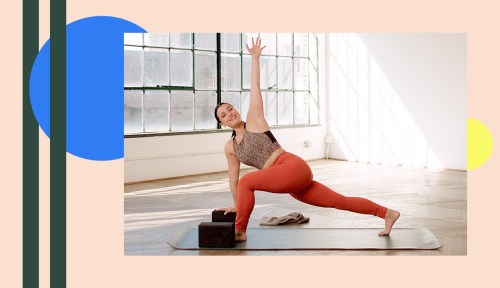If you’re looking to increase your flexibility or relieve muscle tightness, a common strategy is to add some stretching to your weekly routine. But your typical static or dynamic stretching might not be the most effective way to go.
Experts in This Article
board-certified specialist in orthopedic physical therapy and owner of More 4 Life PT
Instead, physical therapists and stretching experts might suggest PNF stretching, which stands for proprioceptive neuromuscular facilitation. This stretching technique involves actively contracting your muscle against resistance to help trigger the muscle to relax. Dave Candy, DPT, an orthopedic physical therapist and owner of More 4 Life PT, explains that the deliberate muscle contraction makes this strategy über effective.
“When you contract a muscle, the tension in the muscle increases, which activates a tension receptor called the Golgi tendon organ. This makes the muscle relax in order to prevent it from being injured,” explains Dr. Candy. “This is a principle referred to as ‘autogenic inhibition’ because the muscle inhibits itself.”
There’s also another PNF principle called “reciprocal inhibition” in which you contract the opposing muscle group, he adds. For instance, when you’re stretching the hamstrings, contracting the quads causes the hamstrings to “shut off” so that you can release them even further.
Research has shown that this approach can be more effective at increasing muscle flexibility than static stretching. Dr. Candy explains that’s likely because a sensory receptor called the muscle spindle senses the increase in tension during static stretching, and limits the amount of stretch you can get. “PNF overcomes this stretch reflex,” he says.
What does PNF stretching feel like?
If you want to try this technique out for yourself, you’re in luck. In Well+Good’s latest Good Stretch routine, trainer Nicole Uribarri shares a 13-minute leg stretch series. It’s designed to “help you improve the performance of your daily activities by helping you lengthen your low back, stretch your hips, your thighs, and your hamstrings,” says Uribarri. One of the very first stretches she begins with uses PNF stretching to open up the hamstrings.
Uribarri has you loop a towel around the ball of one foot, then extend that leg straight up to the sky. “We’re working with a series of contractions and releases,” she says. “Push your foot forward away from you, and then use the energy of your hands in the towel to pull the leg toward you, so you’re gonna feel some activation through the back of your leg. You’re pushing with your leg as you’re pulling with your arms.” After holding for a few seconds, you release the contraction bring the leg closer to you.
“Notice as you release the muscle you’re able to open up your hamstring a little bit more,” Uribarri says, before leading you through two more rounds of that contraction and release.
To make sure I was doing it right, I asked Dr. Candy what PNF stretching should feel like. He described the sensation I should anticipate as one that feels like a gentle stretch just to the point where there is the slightest discomfort.
He advises that once you hit that first little bit of discomfort, you then contract your muscle (in this case, the hamstrings), which temporarily increases the stretch tension. Then relax, and you should be able to stretch slightly further.
How to do PNF stretching safely
Even though PNF stretching can be effective, there are also some risks that you need to keep in mind. Dr. Candy says the most important safety consideration is that you should not be stretching to the point of pain. Not only will this increase the risk of injury, it’s also counterproductive.
“PNF stretching is more of a finesse type of stretching, not a no-pain-no-gain type of stretching. If there’s pain, that’s going to increase muscle tension, which decreases your flexibility,” he warns.
Dr. Candy says you can do PNF stretching on your own. Here is an example:
- Stand with one heel on a chair and the other leg on the ground.
- Lean your trunk forwards until you feel a stretch in your hamstrings.
- Gently dig your heel into the chair for 10 seconds to contract your hamstrings.
- Then, relax and lean your trunk a little farther forward. Again, only stretch to the point of tension, not pain.
Doing Well+Good’s Good Stretch leg stretching routine
With chronic muscle tightness, I make no secret of my distaste for stretching, but I have found that when I try to stick with a simple mobility routine or use a massage gun consistently, I do experience noticeable improvements in not just my flexibility, but how my body feels and moves during my workouts and everyday life activities. The name of the game for me is finding a stretch routine that is brief and easy to follow. That’s exactly what I found with Uribarri’s new series.
The routine is also simple, in that I only needed a couple of yoga blocks and a towel. Even if you don’t have blocks, you can use books or some other little supports you have lying around the house.
The series opens up with a basic single-leg knee-to-chest stretch with some small hip circles. This felt really good because my hips, glutes, and hamstrings are notoriously tight.
Then, I got to put the PNF stretching technique to the test. Using a towel, Uribarri leads us through a single-leg PNF hamstring stretch. I imagine pressing my heel forward and up while simultaneously pulling back on the towel with my arms. I found that with each subsequent attempt at this stretch (over the three bouts Uribarri leads us through), I was able to go deeper and find greater flexibility in my hamstrings.
Next comes a series of other more traditional static stretches that help stretch the hamstrings and open the hips. First there’s a low lunge using yoga blocks to help support your upper body. Then, without moving the feet from where they are on the ground, you pike your hips up into the air and lean forward toward that front foot—I felt a really good stretch in my hamstrings, glutes, lower back, and shoulders with this move.
Then, you drop your hips back down into the low lunge and twist your trunk to the side, reaching one arm up into the air in a world’s greatest stretch. This was a fantastic stretch for not only the hamstrings, but also opening up my hip flexors and groin. Though I have to admit, even though I had the yoga blocks for balance, I still found it a little difficult to balance—which probably demonstrates some weakness in my core and glutes.
Uribarri then has us lean our hips back for a half split, then sits down for a seated twist, followed by a fire log pose to open those hips, before doing it all on the other side.
Honestly, even though the routine is only 13 minutes, the first time I tried it, I had to stop with about five minutes to go because I was feeling like my legs and hips had had far more stretching than I’d done in a while. However, I tried it again the next day and made it through the entire routine.
If you are in the same boat and have chronically tight hamstrings, I would recommend taking the same approach; don’t feel bad if you need to work your way up gradually. Even though this stretch series is perfectly suitable for beginners, as with any aspect of fitness, flexibility exercises can take some time to get used to and there is absolutely no shame honoring how much your body can tolerate.
I would highly recommend going through at least the first half because you will get to try the PNF stretching and it’s pretty interesting how immediately noticeable the differences are using this technique. As you get more comfortable, work your way through the whole video. If your experience is anything like mine, I think that you will find that your hamstrings are finally lengthening out and releasing.
Sign Up for Our Daily Newsletter
Get all the latest in wellness, trends, food, fitness, beauty, and more delivered right to your inbox.
Got it, you've been added to our email list.











